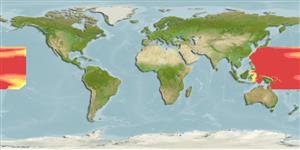>
Perciformes/Serranoidei (Groupers) >
Anthiadidae (Fairy basslets or Streamer basses)
Etymology: Plectranthias: Greek, plektron = anyhting to strike with, spur + Greek, anthias = a fish, Sparus aurata (Ref. 45335); kamii: This species was named in honor of Harry T. Kami of the Division of Fish and Wildlife on Guam who donated the specimen to the Bishop Museum who suspected that it might represent an undescribed species. (Ref. 8944).
More on author: Randall.
Environment: milieu / climate zone / depth range / distribution range
Ecologia
marino; distribuzione batimetrica 183 - 480 m (Ref. 123579). Subtropical; 34°N - 17°S, 119°E - 149°W
Indo-Pacific Ocean: Indonesia to Fr. Polynesia; north to Japan; south to Australia.
Size / Peso / Age
Maturity: Lm ? range ? - ? cm
Max length : 28.0 cm SL maschio/sesso non determinato; (Ref. 123579)
Spine dorsali (totale): 10; Raggi dorsali molli (totale): 17-18; Spine anali 3; Raggi anali molli: 7; Vertebre: 26. This species is distinguished from its congeners by the following set of characters: D X,17-18; the third dorsal spine longest; pectoral rays 13; lateral line is complete, 32-38 tubed scales; scales below lateral line to origin of anal fin 16-20 (Ref. 123579).
Life cycle and mating behavior
Maturità | Riproduzione | Deposizione | Uova | Fecundity | Larve
Gill, A.C., J.J. Pogonoski, G.I. Moore and J.W. Johnson, 2021. Review of Australian species of Plectranthias Bleeker and Selenanthias Tanaka (Teleostei: Serranidae: Anthiadinae), with descriptions of four new species. Zootaxa 4918(1):1-116. (Ref. 123579)
IUCN Red List Status (Ref. 130435)
Threat to humans
Harmless
Human uses
Informazioni ulteriori
Nomi ComuniSinonimiMetabolismoPredatoriEcotossicologiaRiproduzioneMaturitàDeposizioneSpawning aggregationFecundityUovaEgg development
Age/SizeAccrescimentoLength-weightLength-lengthLength-frequenciesMorfometriaMorfologiaLarveDinamica popolazioni larvaliReclutamentoAbbondanzaBRUVS
BibliografiaAcquacolturaProfilo di acquacolturaVarietàGeneticaElectrophoresesEreditarietàMalattieElaborazioneNutrientsMass conversion
Strumenti
Special reports
Download XML
Fonti Internet
Estimates based on models
Preferred temperature (Ref.
123201): 13 - 20.3, mean 15.4 °C (based on 28 cells).
Phylogenetic diversity index (Ref.
82804): PD
50 = 0.5000 [Uniqueness, from 0.5 = low to 2.0 = high].
Trophic level (Ref.
69278): 4.4 ±0.7 se; based on size and trophs of closest relatives
Resilienza (Ref.
120179): Medio, tempo minimo di raddoppiamento della popolazione 1.4 - 4.4 anni (Preliminary K or Fecundity.).
Fishing Vulnerability (Ref.
59153): Low vulnerability (24 of 100).
Nutrients (Ref.
124155): Calcium = 93.9 [43.8, 193.5] mg/100g; Iron = 1.25 [0.60, 2.30] mg/100g; Protein = 18.6 [16.7, 20.4] %; Omega3 = 0.524 [0.316, 0.908] g/100g; Selenium = 21.7 [10.8, 43.0] μg/100g; VitaminA = 24.4 [7.7, 91.0] μg/100g; Zinc = 0.86 [0.59, 1.32] mg/100g (wet weight);
